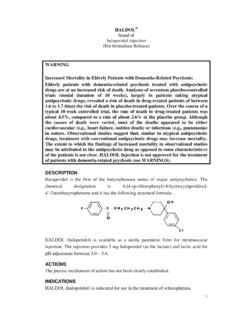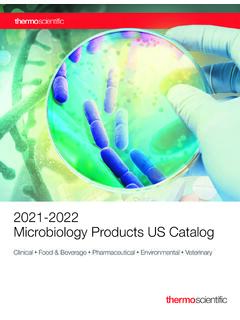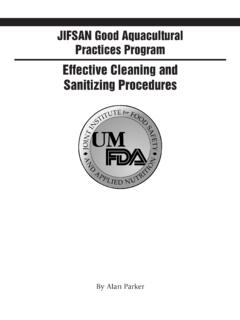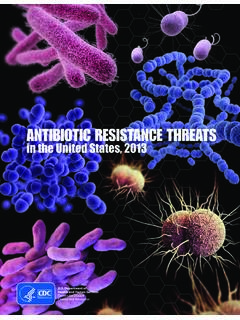Transcription of Chapter 6: Microbial Nutrition and Growth
1 Chapter 6: Microbial Nutrition and GrowthMicrobial Growth : Refers to an increase in cellnumber, not in cell size. Bacteria grow and divide by binaryfission, a rapid and relatively simple for GrowthPhysical : Microbes are looselyclassified into several groups based on their preferred temperature : Cold-loving . Can grow at 0oC. Two groups: True Psychrophiles: Sensitive to temperatures over 20oC. Optimum Growth at 15oC or below. Found in very cold environments (North pole, ocean depths). Seldom cause disease or food spoilage. Psychrotrophs: Optimum Growth at 20 to 30oC. Responsible for most low temperature food for GrowthPhysical : Middle loving . Most bacteria. Include most pathogens and common spoilage organisms.
2 Best Growth between 25 to 40oC. Optimum temperature commonly 37oC. Many have adapted to live in the bodies of for GrowthPhysical : Heat loving . Optimum Growth between 50 to 60oC. Many cannot grow below 45oC. Adapted to live in sunlit soil, compost piles, and hot springs. Some thermophiles form extremely heat resistant endospores. ExtremeThermophiles(Hyperthermophiles):O ptimum Growth at 80oC or higher. Archaebacteria. Most live in volcanic and ocean Rates of Bacterial Groups at Different TemperaturesFood Spoilage TemperaturesAmount of Food and Cooling RateRequirements for GrowthPhysical : Most bacteriaprefer neutral pH ( ). Moldsand yeastgrow in wider pH range, but prefer pH between 5 and 6. Acidityinhibits most Microbial Growth and is used frequently for food preservation ( : pickling).
3 Alkalinityinhibits Microbial Growth , but not commonly used for food preservation. Acidic products of bacterial metabolism interfere with Growth . Buffers can be used to stabilize for GrowthPhysical : Organisms can be classified as: A. Acidophiles: Acid loving . Grow at very low pH ( to ) Lactobacillusproduces lactic acid, tolerates mild Neutrophiles: Grow at pH to Includes most human Alkaliphiles: Alkali loving . Grow at alkaline or high pH (7 to 12 or higher) Vibrio choleraeand Alkaligenes faecalis optimal pH 9. Soil bacterium Agrobacteriumgrows at pH for GrowthPhysical Pressure: Cells are 80 to 90% Hypertonic solutions: High osmotic pressure removes water from cell, causing shrinkage of cell membrane (plasmolysis).
4 Used to control spoilage and Microbial Growth . Sugar in jelly. Salt on Hypotonic solutions: Low osmotic pressure causes water to enter the cell. In most cases cell wall prevents excessive entry of water. Microbe may lyse or burst if cell wall is Versus Hypertonic SolutionPlasmolysis Effects of Osmosis on Bacterial CellsRequirements for GrowthPhysical Pressure: Halophiles: Require moderate to large salt concentrations. Ocean water contains salt. Most bacteria in oceans. Extreme or Obligate Halophiles: Require very high salt concentrations (20 to 30%). Bacteria in Dead Sea, brine vats. Facultative Halophiles: Do not require high salt concentrations for Growth , but tolerate 2% salt or for GrowthChemical : Makes up 50% of dry weight of cell.
5 Structural backbone of all organic compounds. Chemoheterotrophs: Obtain carbon from their energy source: lipids, proteins, and carbohydrates. Chemoautotrophs and Photoautotrophs: Obtain carbon from carbon for GrowthChemical , Sulfur, and Phosphorus:. : Makes up 14% of dry cell weight. Used to form amino acids, DNA, and RNA. Sources of nitrogen: Protein: Most bacteria Ammonium: Found in organic matter Nitrogengas (N2): Obtain N directly from atmosphere. Important nitrogen fixing bacteria, live free in soil or associated with legumes (peas, beans, alfalfa, clover, etc.). Legume cultivation is used to fertilize soil naturally. Nitrates: Salts that dissociate to give for GrowthChemical , Sulfur, and Phosphorus.
6 : Used to form proteins and some vitamins (thiamin and biotin). Sources of sulfur: Protein: Most bacteria Hydrogen sulfide Sulfates: Salts that dissociate to give : Used to form DNA, RNA, ATP, and : Mainly inorganic phosphate salts and for GrowthChemical Requirements3. Other Elements: Potassium, magnesium, and calcium are often required as enzyme cofactors. Calciumis required for cell wall synthesis in Gram positive Elements:.Many are used as enzyme cofactors. Commonly found in tap water. Iron Copper Molybdenum ZincRequirements for GrowthChemical Requirements5. Oxygen: Organisms that use molecular oxygen (O2), produce more energy from nutrients than classify microorganism based on their oxygen Aerobes: Require oxygen to live.
7 Disadvantage: Oxygen is not found in all environments and dissolves poorly in : Pseudomonas, common nosocomial for GrowthChemical Requirements5. Oxygen: Anaerobes: Prefer to use oxygen, but can grow in its absence. Have complex set of enzymes. Examples: E. coli, Staphylococcus, yeasts, and many intestinal Obligate Anaerobes:Cannot use oxygen and are harmed by the presence of toxic forms of : Clostridiumbacteria that cause tetanus and for GrowthChemical Requirements5. Oxygen: D. Aerotolerant Anaerobes: Can t use oxygen, but tolerate its presence. Can break down toxic forms of : Lactobacilluscarries out fermentation regardless of oxygen Microaerophiles:Require oxygen, but at low concentrations. Sensitive to toxic forms of : for GrowthChemical RequirementsToxic Forms ofOxygen: 1.
8 Singlet Oxygen: Extremely reactive form of oxygen, present in phagocytic Superoxide Free Radicals (O2-.):Extremely toxic and reactive form of oxygen. All organisms growing in atmospheric oxygen must produce an enzyme superoxide dismutase (SOD), to get rid of them. SOD is made by aerobes, facultative anaerobes, and aerotolerant anaerobes, but notby anaerobes or : SODO2-.+ O2-.+ 2H+-----> H2O2+ O2 SuperoxideHydrogenfree radicalsperoxideRequirements for GrowthChemical Requirements3. Hydrogen Peroxide (H2O2):Peroxide ion is toxic and the active ingredient of several antimicrobials ( : benzoyl peroxide). There are two different enzymes that break down hydrogen peroxide:A. Catalase: Breaks hydrogen peroxide into water and O2.
9 Common. Produced by humans, as well as many H2O2----------> 2H2O + O2 HydrogenGasperoxideBubblesB. Peroxidase: Converts hydrogen peroxide into + 2H+----------> H2 OHydrogenperoxideMicrobial GrowthCulture MediaCulture Medium: Nutrient material prepared for Microbial Growth in the : Must be sterile Contain appropriate nutrients Must be incubated at appropriate temperatureCulture: Microbes that grow and multiply in or on a culture GrowthCulture MediaSolid Media: Nutrient material that contains a solidifying agent (plates, slants, deeps). The most common solidifier is agar,first used by Robert Koch. Unique Properties of Agar: Melts above 95oC. Once melted, does not solidify until it reaches 40oC. Cannot be degraded by most bacteria.
10 Polysaccharide made by red algae. Originally used as food thickener (Angelina Hesse). Microbial GrowthCulture MediaChemically Defined Media: Nutrient material whose exactchemical composition is known. For chemoheterotrophs, must contain organic source of carbon and energy ( : glucose, starch, etc.). May also contain amino acids, vitamins, and other important building blocks required by microbe. Not widely used. GrowthCulture MediaComplex Media: Nutrient material whose exactchemical composition is notknown. Widely used for heterotrophic bacteria and fungi. Made of extracts from yeast, meat, plants, protein digests, etc. Composition may vary slightly from batch to batch. Energy, carbon, nitrogen, and sulfur requirements are primarily met by protein fragments (peptones).
















